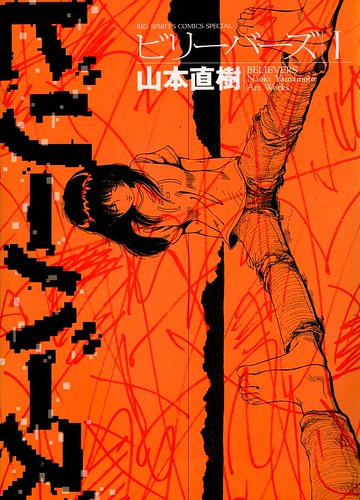
Title: Believers (ビリーバーズ)
Serialized in:Big Spirits Comics Special, August-November 1999
Art and story by: Yamamoto Naoki (山本直樹)
Genre: The communist cult of Gilligan's Island
What it's about:
Poisoned Kool-Aid is so passe. Believers shows us that all the hip Doomsday cults are mixing their cyanide with Sex on the Beach.

From left to right: Operator, Vice Chairperson, and Chairperson.
The Niko Niko Lifestyle Center has sent three of its most pious members to a deserted island for a high-level purification program. Known only by their title—Operator, Chairperson, and Vice Chairperson—their mission follows a rigidly structured pattern of group meditation, roundtable discussion of their dreams, and experiments to test for the emergence of psychic powers. Perfect order, perfect harmony, intersected by the occasional night spent buried up to your armpits in sand to flush the body of poisonous sexual thoughts. A wet dream is tantamount to heresy. Honesty and celibacy are the highest virtues.
The trio are about to have their faith tested in the most harrowing fashion. Food supplies from the mainland are drying up. Tabloids washed up on the beach are filled with mass media propaganda claiming that their organization is on the brink of collapse, its key members arrested for acts of terrorism. Outsiders who drift ashore must be disposed of with extreme impunity. Operator and Vice Chairperson begin harboring a scarlet secret. And Chairperson has been off-kilter since recovering from his fever-induced delirium.
When the only reality you know is the prescribed construct of another, the line between the dreaming and waking world blurs like the froth where the sea meets the land. Believers explores how people use power to influence the thoughts and actions of others, and the manner in which we subjugate ourselves to this influence. While the pressure may be external, it is ultimately an internal choice to subscribe to the group think, even when the only other option is death.
Why it's awesome:
Believers is an allegory for a number of real world cult-related incidents, including the historic, contemporary, and prophetic.

Japanese readers will automatically be reminded of the Aum Shinri Kyo , whose perpetration of the 1995 Sarin gas attacks on the Tokyo subways blacklisted all alternative religions in the public’s eye, harmful or otherwise. In terms of cults, the Niko Niko Lifestyle Center has more in common with Jim Jones and the Peoples Temple than Asahara Shoko and the Aum. It is revealed that the island program was a test to find arable land outside of Japan for a group exodus. This prototype Jonestown later serves as the stage of an attempted “revolutionary suicide” interrupted by military paratroopers—Ironically, the very thing that Jones feared in his last paranoia filled days.
The Aum were the small-minded power fantasy of one man, while The Peoples Temple was an ideological war hidden beneath the robes of religion waged by American communists against capitalism. Yamamoto Naoki is obsessed with Japan's United Red Army, so it’s no surprise that he would model his cult leader after a socialist charisma machine rather than a faux blind bully.
The three characters are encouraged to share their dreams and subsequent interpretations with brutal honesty. Seemingly innocuous comments turn deadly serious when Chairperson begins a forceful probe delving into deeper meaning even if none is to be found. He is relentless, strong arming his opponent to admit to sins they did not commit and a reality they know to be false. His interrogation techniques are disturbingly similar to Mori Tsuneo, the leader of the United Red Army, who killed fourteen of his subordinates in a ritualized lynching designed to awaken their true, inner communist.
(Via the Kamiya Kenkyuusho)
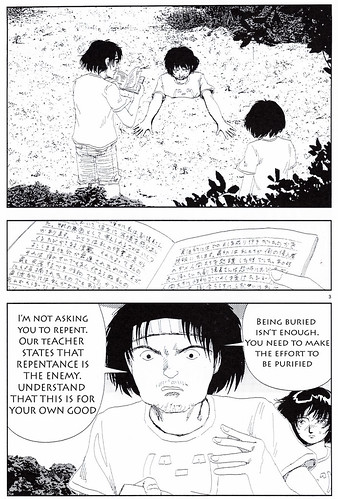
Mori would delver deeper and deeper into the confessions of his comrades, driving them to self damnation. The group knew that the lynching was madness, but none were willing to be the first to stick their neck out. This mountain base purge incident was the epilogue to the Asama-Sanso standoff, and reintroduced the nation to the notion that for fascism to succeed, the will to rule need only be greater than the will to be free. Such a bizarre, yet fitting philosophy deeply affected Yamamoto Naoki and became the core theme of his works, supplemented with elements of sexual domination.
The focus on communism doesn’t mean that Japanese cults are exempt from lampooning. The Pana Wave Laboratories, a mostly benign group led by now-deceased Chino Yuko, decked themselves out in white robes and moved to the mountains in an attempt to block out electromagnetic waves, because, as their home page clearly illustrates, A+B=Scalar waves=Bad! Chairperson shares such eccentricities and won’t touch the computer linking them to the mainland unless he is fully suited up.

The real connection with the Pana Wave Laboratories is a complete coincidence. In 2003, three years after the publication of the manga, the group made national news for fervently protecting an arctic seal found stranded in Tokyo's Tama River. They named the castaway Tama-Chan after the river and drummed up a storm of media coverage in support of the animal that soon turned against them once their particular fashion sense and peculiar aversion to power cables came to light. Believers turns this episode on its head when the starving island dwellers discover a dolphin trapped inside an inlet. Tonight’s menu: Flipper sushi! And this was years before crusades like The Cove were a glimmer of sulfuric acid in Sea Shepard’s eye.
Of course, ask Yamamoto what the story is about, and he’ll answer “hikikomori,” though I suspect this is a cover to keep the Sarin gas trucks and pinko terrorists out of his rose garden. The activities of the three characters, however, should be familiar to the Nintendo generation that grew up playing role playing games in the dark by themselves: They receive orders from headquarters to shuffle around stacks of boxes from one corner to the other, are forced to farm for rare items in the wild, and even level up if they prove themselves pious enough.
The division of labor between Operator, Chairperson, and Vice Chairperson isn’t so different from a MMO's Tank, Healer, and Buffer. If Believers had been written after the release of World of Warcraft, I’m sure we would see ritualized poop-socking.
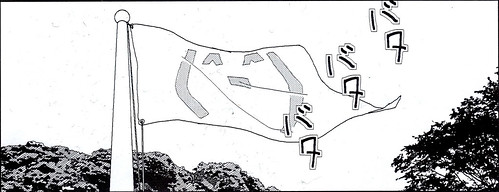
Subtle clues in the art sell the virtual reality vibe. Sound effects are coarse and blocky, recalling eye-gouging Famicon fonts. Backgrounds use actual photographs with a pixilation filter applied to them, which in any other situation would smack of laziness, but here it further muddies the boundary between the digital and the real. We never learn if the Desert Island Program refers to a curricular program or computer program.
With that in mind, either allowing yourself to be brainwashed by a cult, or cosigning your life away to video games both come into focus as shades of the same gray.
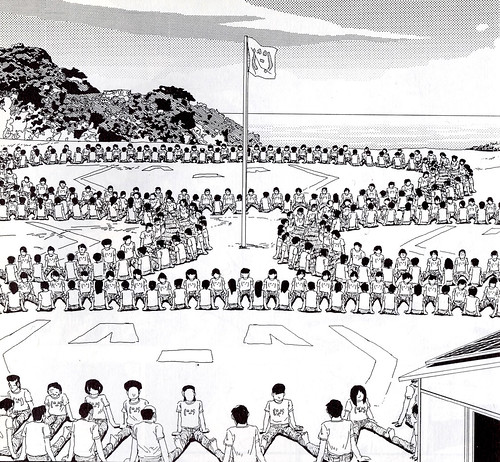
The Age of the Internet offers plenty other ways to induce insulated groupthink. In the manga, cult members channel their cosmic energy by linking together each others' feet while meditating. When viewed from above, this creates an unbroken chain of “w”s, a sight familiar to those who have spent any time on Japan’s premiere streaming video site, Niko Niko Douga. Is this connection to the Niko Niko Lifestyle Center mere coincidence, or is it part of a larger conspiracy by site founder Nishimura Hiroyuki in his bid to ghettoize otakuism into a closed circuit Vocaloid feedback loop?
Why it won't come out in America:
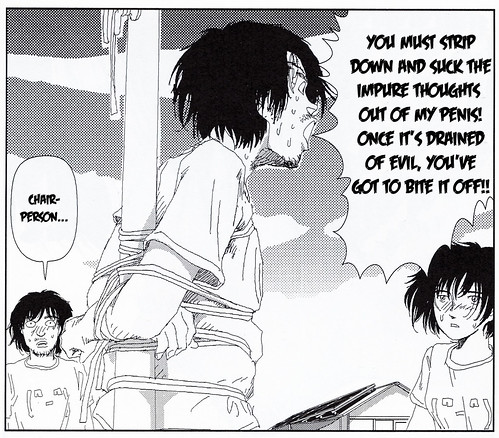
Yamamoto Naoki is infamous for his uncompromising sexual imagery Many of his works have been deemed detrimental to societal morals by the
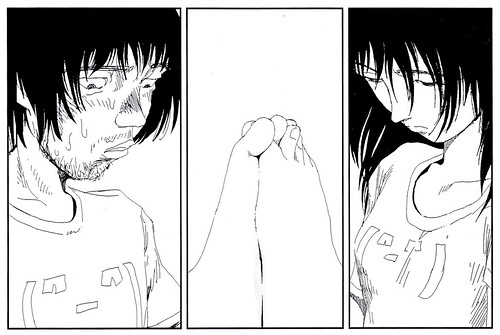
But America still has a long way to go in accepting nekkid cartoons and their glistening naughty bits. If a title is going to draw flak for ambiguously offensive sexuality, a more worthwhile target would be his 1994 masterpiece, Arigato. Arigato shares Believers' main theme: Influence through physical, mental, and sexual abuse, only this time projected through the lens of a contemporary family.
A salary man father returns from a year long assignment in Hokkaido to find his home usurped by a motorcycle gang, his daughters refurbished as drugged-out sex dolls while his wife in an alcoholic stupor. In a show of super human rage, the father manages to fight off the punks and barricades his family safely indoors. But rather than celebrate their liberation, the family turns against dad for not being there to protect them in the first place, who responds by literally keeping them prisoner in the house for their own safety.
Is his overzealous (though well intentioned) fervor to keep his family safe from harm at the cost of their freedom so much better than the carefree (though degrading) utopia provided by the gang? Can relationships and human hearts be repaired once they pass the breaking point? And assuming they can, is it worth the effort?
Yamamoto Naoki juxtaposes the dangers of blind subservience with the mindless bliss of having others think for you. You can't root for his heroes because their conflict is the direct result of personal negligence; you can't boo his villains because their insidious acts are rooted in social malaise as opposed to an inherent evil. He holds us responsible for our actions as much as our inaction. In an age where people view change as a magical outside force, a right promised rather than earned, Yamamoto's unflinching philosophy is needed to rouse within us the courage to take every aspect of life into our own two hands, and mold it into the reality we know to be most just.

Ah, I read this manga a long time ago. It's one of my favorites next to Parasyte, Tropical Citron and 20th Century Boy. But the ending was confusing...
ReplyDeleteCults can go from being very weird to extremely scary. I used to live up in Michigan about 9 years ago and the Militia groups there are something even the law enforcement didn't want to mess with. To me they were similar to cults and there are also other groups of people but I won't mention them here. I never would have known about this manga or artist if you didn't mentioned it. Check out these manga artists FUJISAWA Yuki, INUKI Kanako, KANZAKI Shummi, Ishikawa Yugo, Kigitsu Katsuhisa, MORI Kouji, HAYASHIDA Q, RYOU Haruka and OSHIMI Shuuzou. Those are the only ones I can name off the top of my head but there are others. Now I think Fantagraphics would pick this up or any publisher that has fringe comics in their catalog. I know I mentioned dorohedoro in my pervious comment but I found a cool AMV on youtube.
ReplyDeletehttp://www.youtube.com/watch?v=RBQCLvq7bNc
Flash (or whatever was used) rules.
-Different Anonymous